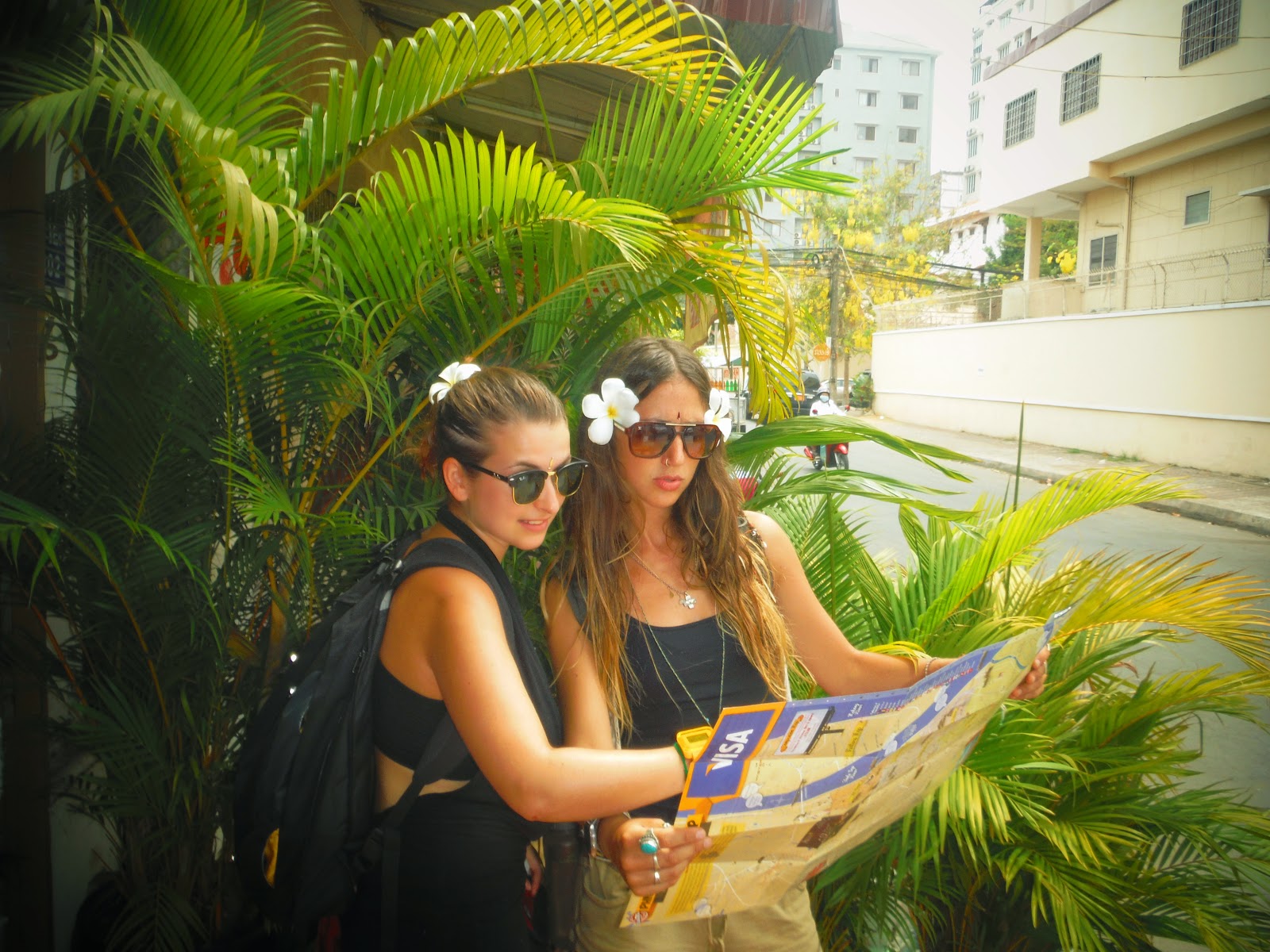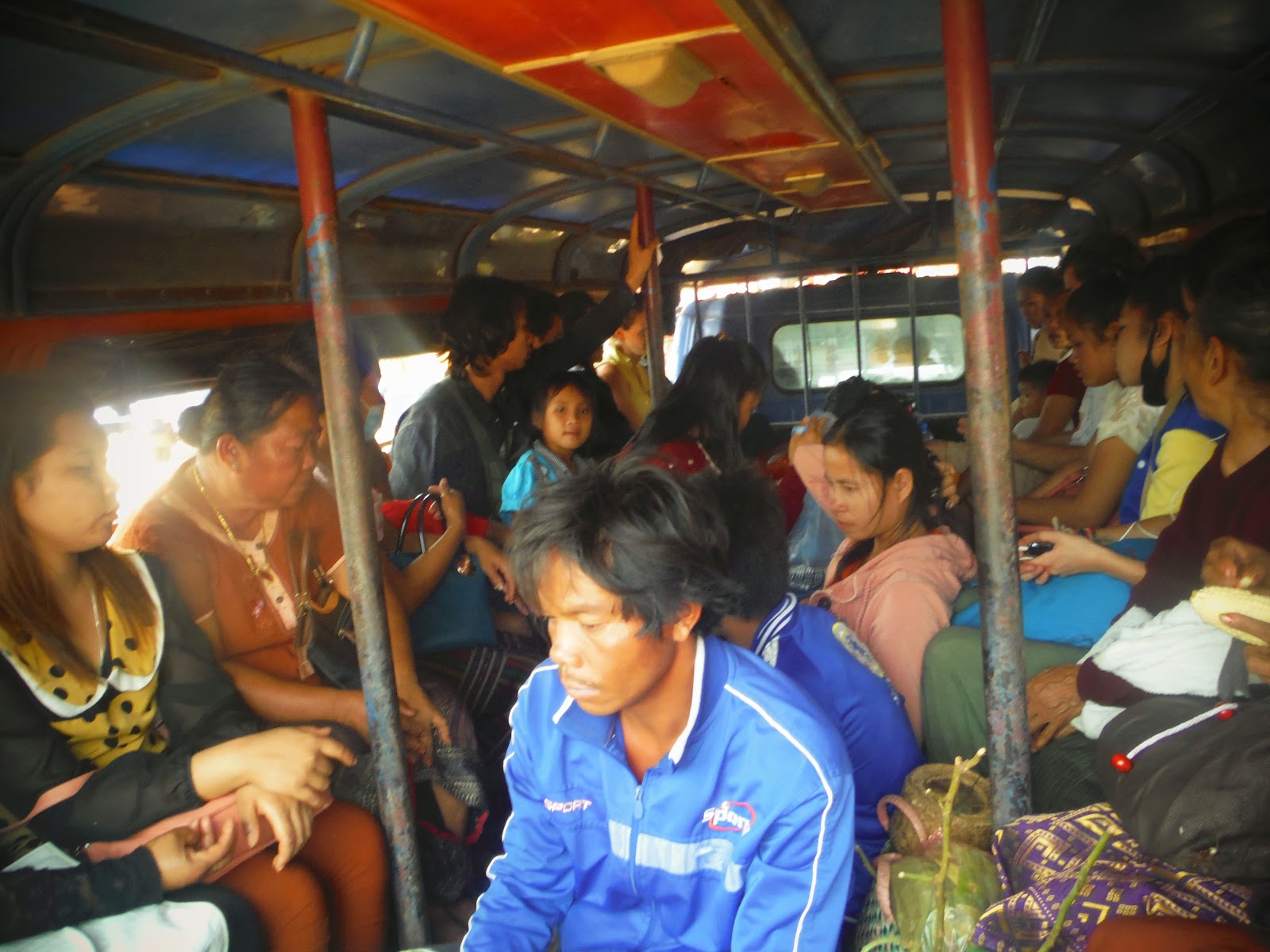I hurried through the night to the address of our hostel which Mia had secured on her arrival the previous day. At the gaudy tourist centre of Siem Reap on the infamous Pub street, I crashed into the clamorous bustle of the heaving masses comprising a spectrum of young travellers, international families and flashy business comfidants. Wading past bars, restaurants and their abundant plastic seating which spilled onto the pavement serving Cambodian broths beside a hoard of roadside hawkers with mountainous piles of fried roaches, grasshoppers, tarantualas and other nauseating unidentifiable creepy crawleys. I found my way to our hostel, after several instances of misinformation offered in tendentious certainty by pereliously helpful locals.
 |
| Reunited |
I quickly showered a day of travel filth from myself and hurried expectantly downstairs to burst excitedly through the glass door and reunite with Mia in a violently vociferous and vigorous embrace in the foyer, which lasted several long moments and was revisited frequently before we prized ourselves apart and naturally headed out for celebratory cocktails. The evening that ensued was a joyous light speed gabble of our precedent stories and a multitude of jubilant selfies of our faces mashed up together.
We woke early the next morning to meet Josh, a ruthlessly ribald 22 year old from Leicester who Mia had met in Thailand the previous month. Nursing a formideable hangover, his amusing lucklustre querelousness continued throughtout the day as we centured off in search of the ancient Khumer temples of Angkor Wat. Meaning 'City of Temples', Angkor Wat was built between the 9th and 14th centuries and is comprised of a cluster of over 300 temples and perhaps the most prominent primordal example of Hindu and Buddhist structures from the ancient past. During Cambodia's turbulent political history, the temples were assiduously assiled by the infamous Khumer Rouge before they were rediscovered and reinstalled in global intrigue by an itinerant French naturalist in the nineteenth century. The crumbling edifices are magnificent mystical marvels of towering faces in the tottering stone work, housed in lofty impressive dry wall and bordered by deep, sinous moats ellegedly sculpted with the jaws of goats. Some have been ravaged by enormous creepers and strangler trees which have become integrated within the stones themselves like some sort of scandent scaffold.
The highlight was seeing Cambodia's historic pride, (and centrepiece of their national flag) the most grand of all the temples named also Ankor Wat. We explored under the ominous gathering of lugubrious cover overhead, before the purpley sky electrified with claps and bright longtitudinal licks of lightening, some of the longest and most striking I'd ever seen, accompanied by deep reverberant rumbles of thunder. We'd met a well spoken Englishman who joined our ranks for the evening, and were amused by the primitave guttural reactions caused by the tumultuous natural war raging overheard, whilst being attacked by a pack of rambumktious Cambodian children who were trying to flog us ground maps despite the temples closing within a matter of minutes, but who thankfully took mainly to physically beating Josh in response to our awe inspired ignorance of their plight.
Envigorated by the energy in the air we ebulliently headed back with the vision of a remedial massage. We were soon dressed in oversized pajamas intended for the most morbidly obese and were causing clamour in our own private massage room. Four equally as impertinent and vaguely insubordinate masseurs gave us substandard simultanous massages but joked with equal fervour amongst themselves, and were utterly hysterical which had us all in stitches. We bid farewell to Patrick and the three of us bundled onto a cramped overnight bus en route to Phnom Phen for an astringent exploration of the city's terrible history.
 |
| A quick cultural interlude... |
In Phnom Pehn, we laboriously trawled the swealtering streets visiting museums of accumilated religious artifacts before heading to two important sites symbolising the inexorable inhumanity of the of the Pol Pot regime. During the destabalising fury of the American embroilment of the Vietnam war, French educated university dropout and extreme communist Pol Pot's gathering anti-imperialist resentment was bubbling menacingly. Once the US finally withdrew and defenses in Cambodia were freed as neighbouring countires had pressing focuses elsewhere, the Khumer Rouge had gathered momentum using anti-American and Vietnemese propeganda based on the disasterous effects of the relentless bombing and subsequent innocent life loss, which resulted in the ruthless revolutionary army toppling Cambodia's government in order to 'liberate' the country in 1975. What ensued was four years of devestating agrarian reform which mercilessly rebuked anyone but campestral farmers, elliminating nearly a quarter of innocent Cambodias suspected of working against the extreme socialist regime. Art, culture, history, market, trade, education, health systems and possesions were outlawed as all city dwellers were marched from the centres in less than 3 days to work the land toward a future of national self sufficiency, in violent protest to America and all global imperialism. Wearing glasses was a sign of intelligence and possible budding treason and was an offense absurdly punishable by death.
5,000 years ago, Cambodia was nothing but water, and as glaciers melted in surrounding mountains the gargantuan surging Mekong deposited silty residue which began to form the landmass of the country. Its aqautic ancestry provided rich, fertile land and was the basis for a belief at the time that the people could produce triple the quantity of rice currently being harvested per year with more fastidious irrigation methods, an ideology debunked since as myth in recent studies. However, Pol Pot enslaved the entire Cambodian population which was put to work as slave to the revolution, ironically suffering starvation and violent atrocities under the malicious regime.
We visited the S-21 detention camp housed menacingly in an abandoned school before venturing far to the outskirts of the city to the horrific Choeung Ek Killing Fields, one of a multitude of sites where innumerable innocent civilians were brutally murdered. Needless to say, the experience was truly desolate and distressing, and having recently read Loung Ung's detailed account of her experiences as a helpless five year old, the episode was all the more bracing. Walking the streets of Phnom Pehn invoked marvel at the interminable resillience and recuperation of its people, as it dawned that a mere 35 years ago this ghost town told grisly tales of an unseen abomination that went generally uninvestigated by the world following a lack of media coverage having become globally fatigued during the Vietnam war. The UN even continued to fund the Khumer Rouge which it recognised as ruling govenment of Cambodia as late as 1980, and the Americans ellegedly offered clandestine support in response to a new alligence with China and US vengance against Vietnam. When reading a book on the rise of the Rouge and the Pol Pot regime outside the Vietnemese consolate one day, a friendly Cambodia laborour became inrigued by my guitar before seeing the book lay at my side and gestured to a stump in place of his forearm, stoically uttering the name of Pol Pot. It was a stark and startling trip coming from the comfortable confines of the democratic West where such atrocities are utterly unimaginable, but the calm and comely countenace of all Cambodians we came across was an inspiring attestation to the endurance of human spirit.



















































